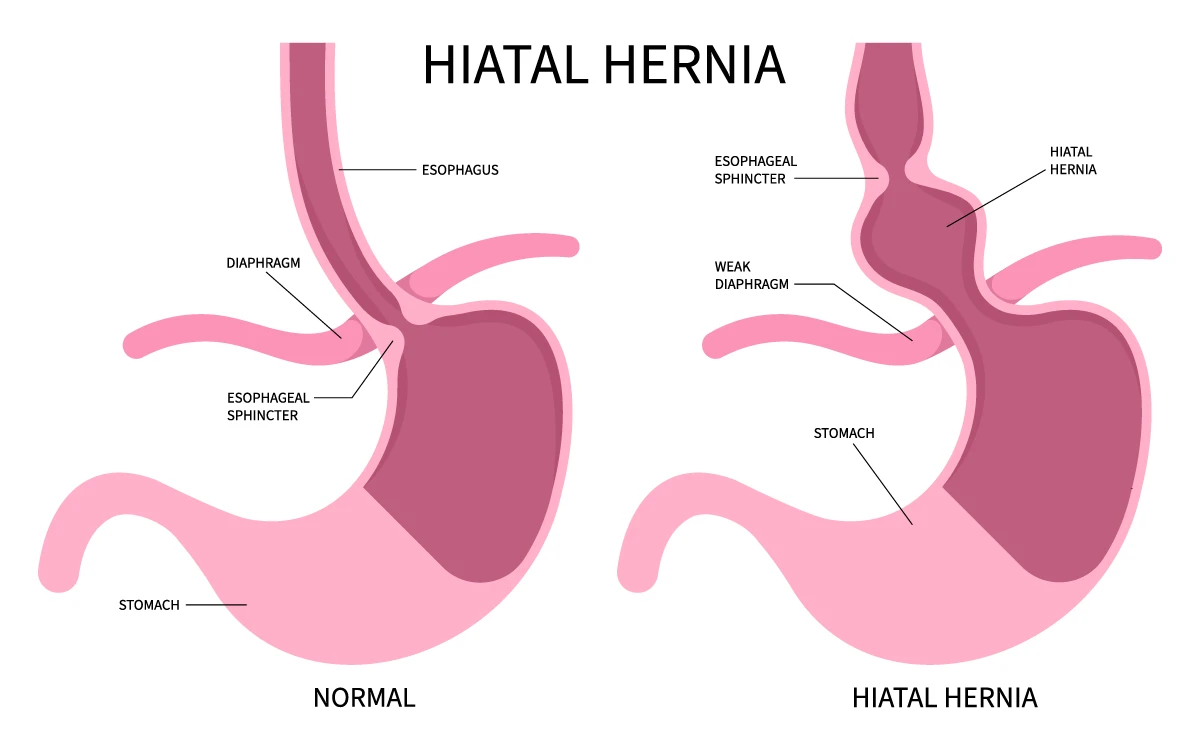Hiatal hernia
Hiatal hernia is a condition where part of your stomach bulges upward through muscles that divide the chest and the abdomen (belly). Some people don’t have symptoms, while some people do. We’re here to help you manage symptoms and provide the treatment you need.
Anatomy of a hiatal hernia

Your stomach and the lower end of your esophagus are normally located just below the diaphragm – the muscles that divide your chest from your abdomen.
At the area where your esophagus feeds into your stomach, there is a muscle called the lower esophageal sphincter. This sphincter opens to let food into your stomach and then closes to keep stomach contents inside.
The closing part is important because once there’s food in your stomach, you start secreting mild acids to help with digestion. Those acids are perfectly safe in your stomach. But if they back up into your esophagus, they can cause a burning sensation and damage to the esophageal lining.
Sometimes the end of the esophagus, the lower esophageal sphincter and part of your stomach slip up through the opening in the diaphragm (hiatus) and end up on top of the diaphragm instead. That’s called a hiatal hernia.
Symptoms of a hiatal hernia
Many people who have a hiatal hernia don’t learn about it unless they have screening tests done because of concerns about their heart, lungs, or other body parts in that area. Others have a variety of symptoms including trouble swallowing, belching, chest pain, heartburn or fatigue.
If you’re concerned about symptoms such as those, make an appointment to see your doctor to find out more. If you’re having chest pain, call your doctor immediately because it may be a sign of another serious condition.
Hiatal hernia causes
There are no known hiatal hernia causes, but some people are more likely to develop them. Women and people older than 50 have a higher risk of hiatal hernia.
Conditions that increase pressure inside the belly (abdomen) seem to contribute to hiatal hernias. The pressure could be from pregnancy, heavy lifting, obesity or even repeated straining on the toilet. Other things that may increase the risk of a hiatal hernia are:
- Age-related changes to the abdomen
- Having a larger-than-normal hiatal opening in the diaphragm
- Injury to the hiatal area
Hiatal hernia diagnosis
Your doctor’s diagnosis starts with a physical exam and talking about your family and personal medical history. They’ll ask about your potential symptoms of hiatal hernia. Depending on your symptoms, they’ll order diagnostic tests which may include any of the following:
- Barium swallow: After you drink a liquid that contains barium, X-rays will be taken at rest and while you swallow. Also known as an esophagogram or upper GI series.
- Motility testing: Measures whether the muscles of the esophagus are working together correctly. Also known as esophageal manometry.
- pH monitoring: Testing for the presence of stomach acid in your esophagus.
- Upper GI endoscopy: An endoscope (flexible tube with a camera, light and tools) is inserted through your throat. It’s used to take pictures of your esophagus and stomach or to take a tissue sample (biopsy). Also known as esophagogastroduodenoscopy (EGD).
Self-care for hiatal hernia
Several actions may help lessen the symptoms of a hiatal hernia. You can avoid substances that trigger symptoms for you. The following things are common triggers for hiatal hernia symptoms:
- Alcohol
- Caffeine
- Chocolate
- Fatty foods
- Peppermint
- Tobacco
Some other things that can make a difference are maintaining a healthy weight and eating smaller, more frequent meals.
Hiatal hernia symptoms are sometimes worse when lying down or trying to sleep, so it helps to avoid lying down right after eating. Try waiting three or four hours after a meal before going to bed. While lying down, elevating your head by about six inches can also help minimize symptoms.
Exercises and some yoga poses that strengthen your diaphragm may improve your symptoms. Consult your doctor about any exercise program.
Following these suggestions and adopting a diet for hiatal hernia relief may improve your symptoms, but they won’t cure a hiatal hernia. Your doctor may recommend medications or surgery for your condition.
Hiatal hernia treatments
Treatments for hiatal hernia vary depending on what your symptoms are and whether your doctor discovers damage to your esophagus.
Medications for hiatal hernia
Over-the-counter and prescription medications are the first line of defense against hiatal hernia symptoms. Your doctor may recommend:
- Antacids: Temporarily soothe some symptoms of hiatal hernia.
- H-2 receptor blocker: Reduces the amount of stomach acid your body makes. May relieve symptoms of hiatal hernia for longer periods of time.
- Proton pump inhibitor (PPI): Blocks stomach acid from being secreted, allowing your esophagus to heal.
Hiatal hernia surgery
Hiatal hernia surgery may be recommended for those who’ve had symptoms for a long time or who have severe damage to the esophagus. This type of thoracic surgery (chest surgery) includes moving your stomach and the lower part of your esophagus back into the abdomen and making the diaphragm opening tighter so it will prevent them from bulging up again. If surgery is recommended for you, your doctor will explain the risks, benefits and what to expect.
Get care
We help you live well. And we’re here for you in person and online.
